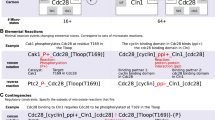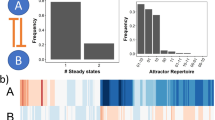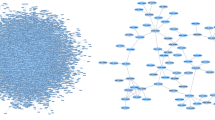Abstract
A major endeavor of systems biology is the construction of graphical and computational models of biological pathways as a means to better understand their structure and function. Here, we present a protocol for a biologist-friendly graphical modeling scheme that facilitates the construction of detailed network diagrams, summarizing the components of a biological pathway (such as proteins and biochemicals) and illustrating how they interact. These diagrams can then be used to simulate activity flow through a pathway, thereby modeling its dynamic behavior. The protocol is divided into four sections: (i) assembly of network diagrams using the modified Edinburgh Pathway Notation (mEPN) scheme and yEd network editing software with pathway information obtained from published literature and databases of molecular interaction data; (ii) parameterization of the pathway model within yEd through the placement of 'tokens' on the basis of the known or imputed amount or activity of a component; (iii) model testing through visualization and quantitative analysis of the movement of tokens through the pathway, using the network analysis tool Graphia Professional and (iv) optimization of model parameterization and experimentation. This is the first modeling approach that combines a sophisticated notation scheme for depicting biological events at the molecular level with a Petri net–based flow simulation algorithm and a powerful visualization engine with which to observe the dynamics of the system being modeled. Unlike many mathematical approaches to modeling pathways, it does not require the construction of a series of equations or rate constants for model parameterization. Depending on a model's complexity and the availability of information, its construction can take days to months, and, with refinement, possibly years. However, once assembled and parameterized, a simulation run, even on a large model, typically takes only seconds. Models constructed using this approach provide a means of knowledge management, information exchange and, through the computation simulation of their dynamic activity, generation and testing of hypotheses, as well as prediction of a system's behavior when perturbed.
This is a preview of subscription content, access via your institution
Access options
Access Nature and 54 other Nature Portfolio journals
Get Nature+, our best-value online-access subscription
$29.99 / 30 days
cancel any time
Subscribe to this journal
Receive 12 print issues and online access
$259.00 per year
only $21.58 per issue
Buy this article
- Purchase on Springer Link
- Instant access to full article PDF
Prices may be subject to local taxes which are calculated during checkout





Similar content being viewed by others
References
O'Hara, L. et al. Modelling the structure and dynamics of biological pathways. PLoS Biol. 14, e1002530 (2016).
Raza, S. et al. A logic-based diagram of signalling pathways central to macrophage activation. BMC Syst. Biol. 2, 36 (2008).
Freeman, T.C., Raza, S., Theocharidis, A. & Ghazal, P. The mEPN scheme: an intuitive and flexible graphical system for rendering biological pathways. BMC Syst. Biol. 4, 65 (2010).
Kitano, H., Funahashi, A., Matsuoka, Y. & Oda, K. Using process diagrams for the graphical representation of biological networks. Nat. Biotechnol. 23, 961–966 (2005).
Kohn, K.W., Aladjem, M.I., Weinstein, J.N. & Pommier, Y. Molecular interaction maps of bioregulatory networks: a general rubric for systems biology. Mol. Biol. Cell 17, 1–13 (2006).
Moodie, S.L., Sorokin, A., Goryanin, I. & Ghazal, P. A graphical notation to describe the logical interactions of biological pathways. J. Integr. Bioinform. 3, 11 (2006).
Novere, N.L. et al. The systems biology graphical notation. Nat. Biotechnol. 27, 735–741 (2009).
Lopez, C.F., Muhlich, J.L., Bachman, J.A. & Sorger, P.K. Programming biological models in Python using PySB. Mol. Syst. Biol. 9, 646 (2013).
Beltrame, L. et al. The Biological Connection Markup Language: a SBGN-compliant format for visualization, filtering and analysis of biological pathways. Bioinformatics 27, 2127–2133 (2011).
Calzone, L., Gelay, A., Zinovyev, A., Radvanyi, F. & Barillot, E. A comprehensive modular map of molecular interactions in RB/E2F pathway. Mol. Syst. Biol. 4, 173 (2008).
Kuperstein, I. et al. Atlas of Cancer Signalling Network: a systems biology resource for integrative analysis of cancer data with Google Maps. Oncogenesis 4, e160 (2015).
Oda, K. & Kitano, H. A comprehensive map of the toll-like receptor signaling network. Mol. Syst. Biol. 2, 2006.0015 (2006).
Oda, K., Matsuoka, Y., Funahashi, A. & Kitano, H. A comprehensive pathway map of epidermal growth factor receptor signaling. Mol. Syst. Biol. 1, 2005.0010 (2005).
Raza, S. et al. Construction of a large scale integrated map of macrophage pathogen recognition and effector systems. BMC Syst. Biol. 4, 63 (2010).
Wentker, P. et al. An interactive macrophage signal transduction map facilitates comparative analyses of high-throughput data. J. Immunol. 198, 2191–2201 (2017).
Matsuoka, Y., Funahashi, A., Ghosh, S. & Kitano, H. Modeling and simulation using CellDesigner. Methods Mol. Biol. 1164, 121–145 (2014).
Demir, E. et al. The BioPAX community standard for pathway data sharing. Nat. Biotechnol. 28, 935–942 (2010).
Kanehisa, M., Goto, S., Sato, Y., Furumichi, M. & Tanabe, M. KEGG for integration and interpretation of large-scale molecular data sets. Nucleic Acids Res. 40, D109–D114 (2012).
Wu, G., Dawson, E., Duong, A., Haw, R. & Stein, L. ReactomeFIViz: a cytoscape app for pathway and network-based data analysis. F1000Res 3, 146 (2014).
Yamada, T., Letunic, I., Okuda, S., Kanehisa, M. & Bork, P. iPath2.0: interactive pathway explorer. Nucleic Acids Res. 39, W412–W415 (2011).
Czauderna, T., Klukas, C. & Schreiber, F. Editing, validating and translating of SBGN maps. Bioinformatics 26, 2340–2341 (2010).
Croft, D. et al. The reactome pathway knowledgebase. Nucleic Acids Res. 42, D472–D477 (2014).
Joshi-Tope, G. et al. Reactome: a knowledgebase of biological pathways. Nucleic Acids Res. 33, D428–432 (2005).
Kuperstein, I. et al. NaviCell: a web-based environment for navigation, curation and maintenance of large molecular interaction maps. BMC Syst. Biol. 7, 100 (2013).
Mi, H. & Thomas, P. PANTHER pathway: an ontology-based pathway database coupled with data analysis tools. Methods Mol. Biol. 563, 123–140 (2009).
Hucka, M. et al. The systems biology markup language (SBML): a medium for representation and exchange of biochemical network models. Bioinformatics 19, 524–531 (2003).
Bause, F. & Kritzinger, P.S. Stochastic Petri Nets: An Introduction to the Theory (Vieweg & Teubner, 1996).
Reddy, V.N., Mavrovouniotis, M.L. & Liebman, M.N. Petri net representations in metabolic pathways. Proc. Int. Conf. Intell. Syst. Mol. Biol. 1, 328–336 (1993).
Bahi-Jaber, N. & Pontier, D. Modeling transmission of directly transmitted infectious diseases using colored stochastic Petri nets. Math. Biosci. 185, 1–13 (2003).
Chaouiya, C. Petri net modelling of biological networks. Brief Bioinform. 8, 210–219 (2007).
Heiner, M., Koch, I. & Will, R. Model validation of biological pathways using Petri nets – demonstrated for apoptosis. Biosystems 75, 15–28 (2004).
Peleg, M., Rubin, D. & Altman, R.B. Using Petri net tools to study properties and dynamics of biological systems. J. Am. Med. Inform. Assoc. 12, 181–199 (2005).
Taubner, C., Mathiak, B., Kupfer, A., Fleischer, N. & Eckstein, S. Modelling and simulation of the TLR4 pathway with coloured Petri nets. Conf. Proc. IEEE Eng. Med. Biol. Soc. 1, 2009–2012 (2006).
Balazki, P., Lindauer, K., Einloft, J., Ackermann, J. & Koch, I. MONALISA for stochastic simulations of Petri net models of biochemical systems. BMC Bioinform. 16, 215 (2015).
Marwan, W., Rohr, C. & Heiner, M. Petri nets in Snoopy: a unifying framework for the graphical display, computational modelling, and simulation of bacterial regulatory networks. Bact. Mol. Netw.: Methods Protoc. 804, 409–437 (2012).
Ramos, H. et al. The protein information and property explorer 2: gaggle-like exploration of biological proteomic data within one webpage. Proteomics 11, 154–158 (2011).
Ruths, D., Muller, M., Tseng, J.T., Nakhleh, L. & Ram, P.T. The signaling petri net-based simulator: a non-parametric strategy for characterizing the dynamics of cell-specific signaling networks. PLoS Comput. Biol. 4, e1000005 (2008).
Li, C. et al. Structural modeling and analysis of signaling pathways based on Petri nets. J. Bioinform. Comput. Biol. 4, 1119–1140 (2006).
David, R. & Alla, H. Discrete, Continuous, and Hybrid Petri Nets, 2nd edn. (Springer, 2010).
Theocharidis, A., van Dongen, S., Enright, A.J. & Freeman, T.C. Network visualization and analysis of gene expression data using BioLayout Express(3D). Nat. Protoc. 4, 1535–1550 (2009).
Polak, M.E., Ung, C.Y., Masapust, J., Freeman, T.C. & Ardern-Jones, M.R. Petri net computational modelling of Langerhans cell interferon regulatory factor network predicts their role in T cell activation. Sci. Rep. 7, 668 (2017).
Di Ventura, B., Lemerle, C., Michalodimitrakis, K. & Serrano, L. From in vivo to in silico biology and back. Nature 443, 527–533 (2006).
de Jong, H. Modeling and simulation of genetic regulatory systems: a literature review. J. Comput. Biol. 9, 67–103 (2002).
Friesen, W.O. & Block, G.D. What is a biological oscillator? Am. J. Physiol. 246, R847–853 (1984).
Pertsovskaya, I., Abad, E., Domedel-Puig, N., Garcia-Ojalvo, J. & Villoslada, P. Transient oscillatory dynamics of interferon beta signaling in macrophages. BMC Syst. Biol. 7, 59 (2013).
Acknowledgements
We are grateful to P. Digard and D. Hume for helpful discussions and advice; we thank A. Theocharidis for all his work on developing Graphia Professional. The Hedgehog signaling pathway model (Supplementary Data) was generated by M. Graute, a University of Edinburgh final-year B.Sc. student, as part of a 10-week elective course. We also thank the Biotechnology and Biological Sciences Research Council (BBSRC), which funded the development of BioLayout Express3D, the academic forerunner of Graphia Professional (BB/F003722/1 and BB/I001107/1). T.C.F. was supported by an Institute Strategic Program Grant on Transcriptomes, Networks and Systems (BBS/E/D/20211552).
Author information
Authors and Affiliations
Corresponding author
Ethics declarations
Competing interests
There is now a commercial and supported version of BioLayout Express3D called Graphia Professional, produced by Kajeka Ltd., (Edinburgh, UK) that possesses all the functionality described here for pathway modeling. T.C.F. is a founder and director of Kajeka, and T.A. is employed by the company as a software engineer. The other authors declared no competing financial interests.
Supplementary information
Supplementary Data
mEPN palette for loading within yEd software; interferon-β signaling pathway components; primary network motifs drawn in Petri net style for testing the SPN algorithm; interferon-β signaling pathway; example of a more complex model, the Hedgehog signaling pathway; and examples of changing parameters—interferon-β signaling pathway. (ZIP 162 kb)
Video of the interferon-β signaling pathway simulation run within BioLayout
The video shows the process of model loading, running the simulation, inspecting token accumulation on specific components and watching the flow of tokens run through the model as an animation. See the Supplementary Data. (MP4 3735 kb)
Rights and permissions
About this article
Cite this article
Livigni, A., O'Hara, L., Polak, M. et al. A graphical and computational modeling platform for biological pathways. Nat Protoc 13, 705–722 (2018). https://doi.org/10.1038/nprot.2017.144
Published:
Issue Date:
DOI: https://doi.org/10.1038/nprot.2017.144
This article is cited by
-
Transcriptomic analysis of caecal tissue in inbred chicken lines that exhibit heritable differences in resistance to Campylobacter jejuni
BMC Genomics (2021)
-
PlantSimLab - a modeling and simulation web tool for plant biologists
BMC Bioinformatics (2019)
-
A genomic analysis and transcriptomic atlas of gene expression in Psoroptes ovis reveals feeding- and stage-specific patterns of allergen expression
BMC Genomics (2019)
-
Modelling steroidogenesis: a framework model to support hypothesis generation and testing across endocrine studies
BMC Research Notes (2018)
Comments
By submitting a comment you agree to abide by our Terms and Community Guidelines. If you find something abusive or that does not comply with our terms or guidelines please flag it as inappropriate.



